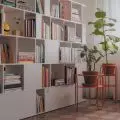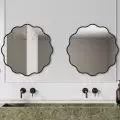Modern construction dominated by masonry and reinforced concrete buildings is becoming a serious environmental problem. It leads to heat islands, excessive carbon dioxide emissions and "concreting," resulting in a lack of greenery in urban spaces. An example of such negative phenomena is the campus of the Vienna University of Economics, where the lack of greenery and shade has resulted in increased temperatures on its grounds. In response to these challenges, {tag:studenci} from the Faculty of Architecture at the Cracow University of Technology created a design for an eco-friendly building for male and female students at the Vienna university.
entrance to the building
© Aleksandra Rosek
green haven for male and female students
The main goal was to provide a space for rest, leisure and integration of the student community in an environment conducive to relaxation and contact with nature. The project refers to the ecological ideas of Vienna and involves the construction of a facility made of 100% wood and wood-based materials. The only concrete element is the foundation slab. The building consists of two parts separated by an atrium, which provides excellent light to all rooms and access to fresh air. The two parts are connected by a wooden structure with pergolas that protect from sun and rain, while creating interesting chiaroscuro effects and providing support for vegetation.
atrium
© Aleksandra Rosek
modular design and community integration with nature
The building is based on a modular grid measuring 30 m x 30 m and 9 m high, with a glulam substructure. The walls act as infill, bracing and insulation, allowing the building's shape to be modified, expanded or dismantled. The project uses eco-friendly technologies such as recuperation, heat pump and ground heat exchanger.
view from the terrace
© Aleksandra Rosek
The building is located in a park, which allows users and occupants to get in touch with nature, calm down and improve their well-being. Special acid-etched glass prevents birds from colliding with the glass surfaces. Green roofs, atriums, climbing vegetation and new greenery create biologically active spaces that fit harmoniously into the park environment.
elevation from the park side
© Aleksandra Rosek
functionality
The facility offers three main activities: a cafeteria, a gym and a project space. These functions respond to the needs of students and park users, fostering the integration of different social and age groups. Aleksandra Rosiek's project is an example of a building that becomes a part of nature, rather than its adversary. Thanks to such initiatives, urban spaces can become more friendly to both people and the environment.
interior fragment
© Aleksandra Rosek


















































